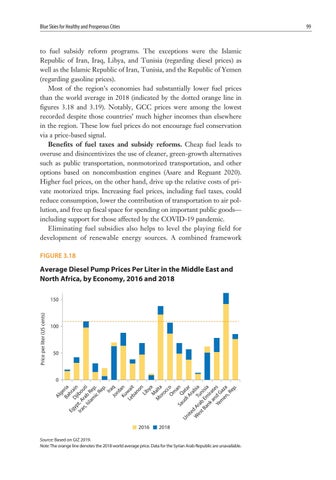Blue Skies for Healthy and Prosperous Cities
99
to fuel subsidy reform programs. The exceptions were the Islamic Republic of Iran, Iraq, Libya, and Tunisia (regarding diesel prices) as well as the Islamic Republic of Iran, Tunisia, and the Republic of Yemen (regarding gasoline prices). Most of the region’s economies had substantially lower fuel prices than the world average in 2018 (indicated by the dotted orange line in figures 3.18 and 3.19). Notably, GCC prices were among the lowest recorded despite those countries’ much higher incomes than elsewhere in the region. These low fuel prices do not encourage fuel conservation via a price-based signal. Benefits of fuel taxes and subsidy reforms. Cheap fuel leads to overuse and disincentivizes the use of cleaner, green-growth alternatives such as public transportation, nonmotorized transportation, and other options based on noncombustion engines (Asare and Reguant 2020). Higher fuel prices, on the other hand, drive up the relative costs of private motorized trips. Increasing fuel prices, including fuel taxes, could reduce consumption, lower the contribution of transportation to air pollution, and free up fiscal space for spending on important public goods— including support for those affected by the COVID-19 pandemic. Eliminating fuel subsidies also helps to level the playing field for development of renewable energy sources. A combined framework FIGURE 3.18
Average Diesel Pump Prices Per Liter in the Middle East and North Africa, by Economy, 2016 and 2018
Price per liter (US cents)
150
100
50
Al ge Ba ria hr Eg yp Dj ain i t b Ira , A o n, ra uti Isl b R am e ic p. Re p. Ira Jo q rd Ku an Le wai ba t no n Lib ya M M alta or oc c Om o a Sa Q n ud at Un i A ar ite ra b W dA es ra Tun ia t B b E is an m ia k a ira n te Ye d G s m a en za ,R ep .
0
2016
2018
Source: Based on GIZ 2019. Note: The orange line denotes the 2018 world average price. Data for the Syrian Arab Republic are unavailable.






